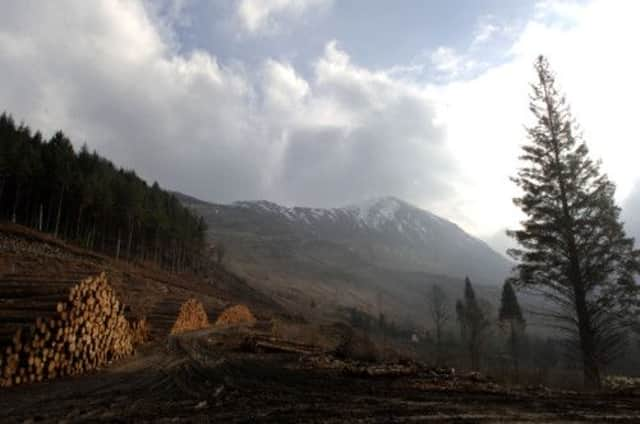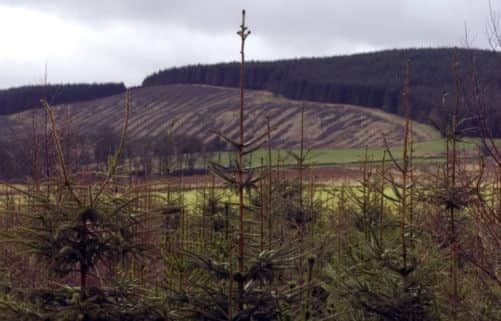Urgent incentives needed for forests in Scotland


The phrase “You can’t see the wood for the trees” has never been more appropriate. The world is running out of timber, yet Scotland appears oblivious to both the dire consequences and the enormous opportunities being missed.
Annually, global timber use is around four billion tonnes, with greater demand from a rising population, rapid industrialisation in China and India, and initiatives to negate the effects of climate change by replacing “high carbon” construction materials such as concrete and steel with “low carbon” timber. Perhaps the most significant pressure on timber supply is the increase in the use of wood as fuel.
Advertisement
Hide AdAdvertisement
Hide AdScotland contributes 65 per cent of total UK wood production, yet it is still a net importer of timber and timber products. Although Scotland is more heavily forested than the rest of the UK, the total area of around 18 per cent compares poorly with a 37 per cent EU average.


Forestry provides almost 40,000 jobs
Given our dependency on imported wood, it is surprising that timber security is not a priority in Scotland, where forestry provides almost 40,000 jobs and £1.7 billion in annual added economic value.
There is a long history of harvesting trees to provide timber – the two world wars highlighted the need to establish a reliable domestic source of timber for times of crisis. The Forestry Commission was formed in 1919 to create this strategic supply.
After the Second World War, afforestation continued, particularly from the 1960s to the mid-1980s and a more affluent, mobile population began taking an interest in the land and landscape, questioning the way forests were established and managed.
Government and industry responded by shifting forest management away from timber production, and the public came to view forests in terms of access and the environment. Now, both public and private forests are exemplars of multiple use: they can combine economic timber production, access and recreation and significant environmental benefits –acting as a carbon sink and enhancing biodiversity.
As the environment moved to the top of the priority list and timber production fell, forest managers concentrated on wildlife conservation and recreation, and rates of new planting of commercial conifer species plummeted to the current pitifully low level.
In Scotland, which has the greatest potential for forest expansion, little more than 500 hectares of new planting in 2012 was commercial – a fraction of what is needed to maintain production and support future investment and jobs. We are way off the Scottish Government’s annual target of 6,000 hectares of commercial forest planting.
Attitudes towards “commercial forestry” and “the environment” remain polarised. The public and politicians in the UK have acquired a narrow view of the purpose of forests. This must change.
Advertisement
Hide AdAdvertisement
Hide AdThe public needs to understand what wood is used for – timber frames, flooring, boarding, beams and joists, decking, pallets and fencing – as well as how much they use and where it comes from.
Expansion of forest area has to begin immediately
If we use more wood than we produce, it has to come from somewhere else, and there is already over-exploitation and forest degradation in many countries.
The expansion of Scotland’s forest area has to begin immediately. Financial inducements will be needed to encourage landowners to plant trees. The obvious way is through tax incentives, but with tight controls.
A fairer balance in support mechanisms offered to agriculture and forestry is also needed if sufficient land is to become available. The Common Agricultural Policy has consistently favoured agriculture at the expense of forestry. This must change.
The real danger is a continuing “live for now” attitude. Increased demand for wood fuel has led to higher prices and could bring about a major shift from a global wood surplus to a wood deficit, leaving us at the mercy of world markets.
Even if politicians prioritise forest expansion now, it will require at least 50 years before the timber is ready. Production cannot be turned on and off to suit markets; it requires steady, long-term development.
In addition, expanding the commercial forest area is perhaps the single greatest opportunity to boost rural economies and employment prospects in a sustainable way.
We need to start seeing the wood, as well as the trees.
• Dr Andrew Cameron is a senior lecturer in Forestry at the University of Aberdeen. He is backing the campaign by Confor: promoting forestry and wood to increase planting of commercial forestry. www.confor.org.uk